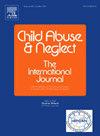对经历过性虐待的儿童的精神病理学与社会人口学、临床和虐待特征之间关系的研究
IF 3.4
2区 心理学
Q1 FAMILY STUDIES
引用次数: 0
摘要
儿童性虐待会对精神造成严重的长期影响。虐待的类型(插入式或非插入式)以及与施暴者的关系,包括乱伦,可能会影响这些结果。目的本研究的目的是检查遭受过性虐待的儿童的社会人口学和临床特征,他们所接触的虐待类型,并评估这些经历对精神病学的影响。该研究包括90名儿童,他们被转介到伊斯坦布尔法医研究所。方法对施暴前后的社会人口学信息、施暴类型、施暴者关系、精神状态等进行评估。采用基于dsm -5的精神病学访谈和各种量表(创伤后应激量表、抑郁量表、焦虑量表)对数据进行分析。结果研究对象中女性占94.4%,男性占5.6%。最常见的性侵犯类型是“触摸/抚摸”(42.7%)。72%的乱伦案件中出现了反复的虐待。抑郁症和创伤后应激障碍(PTSD)被确定在插入性虐待的情况下更常见。乱伦案件的肇事者比非乱伦案件的肇事者年龄大。遭受性虐待的儿童中有71.9%出现PTSD, 33.7%出现抑郁症,11.2%出现焦虑症,15.7%出现适应障碍。结论性侵对受害者造成严重的精神和社会影响。特别是,与非插入性和非乱伦性虐待相比,插入性和乱伦性虐待案件具有更大的破坏性后果。信息性研究和早期干预对于减少这些情况至关重要。本文章由计算机程序翻译,如有差异,请以英文原文为准。
An examination of the relationship between psychopathology and the sociodemographic, clinical, and abuse characteristics in children who have experienced sexual abuse
Background
Sexual abuse in children can have significant long-term psychiatric consequences. The type of abuse (penetrative vs. non-penetrative) and the relationship to the perpetrator, including incest, may influence these outcomes.
Objective
The aim of this study was to examine the sociodemographic and clinical characteristics of children who have experienced sexual abuse, the types of abuse they were exposed to, and to evaluate the psychiatric effects of these experiences.
Participants and setting
The study included 90 children who were referred to the Istanbul Forensic Medicine Institute.
Methods
Evaluations were made of the sociodemographic information, the type of abuse, the relationship of the perpetrator, and psychiatric status before and after the event. The data were analyzed using DSM-5-based psychiatric interviews and various scales (Post-Trauma Stress Scale, Depression Scale, Anxiety Scale).
Results
The study participants comprised 94.4 % female and 5.6 % male children. The most common type of sexual abuse was determined to be “touching/stroking” (42.7 %). Repeated abuse was seen in 72 % of the incest cases. Depression and post-traumatic stress disorder (PTSD) were determined to be more common in cases of penetrative abuse. The perpetrators in incest cases were older than those in non-incest cases. PTSD was seen in 71.9 % of the children after sexual abuse, depression in 33.7 %, anxiety disorder in 11.2 %, and adjustment disorder in 15.7 %.
Conclusion
Sexual abuse leaves severe psychiatric and social effects on the victims. Penetrative and incest abuse cases, in particular, were associated with more destructive outcomes compared to non-penetrative and non-incest abuse. Informative studies and early intervention are of critical importance in reducing these situations.
求助全文
通过发布文献求助,成功后即可免费获取论文全文。
去求助
来源期刊

Child Abuse & Neglect
Multiple-
CiteScore
7.40
自引率
10.40%
发文量
397
期刊介绍:
Official Publication of the International Society for Prevention of Child Abuse and Neglect. Child Abuse & Neglect The International Journal, provides an international, multidisciplinary forum on all aspects of child abuse and neglect, with special emphasis on prevention and treatment; the scope extends further to all those aspects of life which either favor or hinder child development. While contributions will primarily be from the fields of psychology, psychiatry, social work, medicine, nursing, law enforcement, legislature, education, and anthropology, the Journal encourages the concerned lay individual and child-oriented advocate organizations to contribute.
 求助内容:
求助内容: 应助结果提醒方式:
应助结果提醒方式:


